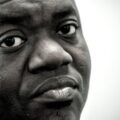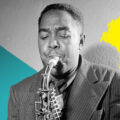No Shatner: On Arise and Go!
Projects mixing two genres always face a doubled risk: the alienation of not one, but two core audiences, and a consequently barren existence deep in the canyon between one domain and another. Between poetry and music, that canyon is well-traveled but sparsely settled. Poetry, it can be argued, is already musical, and is diminished by the rigidity of a timed musical structure. Songs, likewise, are normally not enhanced by having somebody speak the lyrics at the same time as the singer sings them. If they were, wouldn’t we make a habit of it? However, in Arise and Go!, Stephen James Smith and Enda Reilly don’t just shoehorn one form into another and let the chips fall where they may — these recordings are alive with subtleties and minute relationships that reward repeated listens.
It may be useful to begin with some thoughts on the relationship between music and speech, since the recipe Smith and Reilly use is really an expression of these two ingredients in various relationships. Garrett Sholdice writes in The Journal of Music:
There is a special, almost non-definable, congruency between our experiences of music and narrative: what is singing but a stylised speaking — and enhancing — of a story?
Sholdice hovers around the idea that, in some way, singing and speech each contain elements of the other: that you could, theoretically, dial up the singing-ness of speaking until you were in full song — hold the vowels longer than normal, confine the range of spoken pitches, and make the timing somewhat regular. “We are all singing. We call it speech, but we’re singing to each other,” said Brian Eno, in an interview this summer. He continued: “I thought, as soon as you put spoken word onto music, you start to hear it like singing anyway. You start to develop musical value and musical weight, and you start to notice how this word falls on that beat, and so on.”
All of this resonates with Arise and Go!, the 8-track EP released October 2011 by two Dublin-based performers, poet Stephen James Smith and folk musician/songwriter Enda Reilly. On most of the tracks, Enda sings and plays guitar while Stephen speaks the poetry. They often do these things at the same time, or in a back-and-forth alternation. Most of the songs are Irish poems set to music, and some are set to existing melodies — like the famous “Raglan Road” by Patrick Kavanagh, as sung by Luke Kelly — while others are set to new music composed by Reilly. Some are in Irish, English, or both languages. Of the two new pieces, one is only sung while the other is only spoken. Opening with “Mise Eire” (“I am Ireland”) and ending with “Amhrán Na Bfhiann” (“The Soldiers Song,” Ireland’s national anthem), the project is saturated in Irishness.
It is difficult to situate the album in relation to other work. It does not have many close neighbors in popular culture, or even in popular subcultures. It could have a great deal in common with rap, but doesn’t. Rather, the album sounds like what it is: one person delivering a poem in speech while the other sings. There’s a relationship between the two, especially in how Smith runs ahead of and behind the sung text, but Smith is freer than an emcee in his relation to the timing of the music, not needing to work primarily within the rhythm. If there is an elephant in the room, it might be William Shatner’s album, Has Been. That’s how far you have to go to find a popular reference point. Put another way: more is held in common with Shatner’s experiment than with hip-hop. But while the rhythmic drive and integration of rap is largely missing, so is the half-ironic kitsch of Shatner. The relationship between poetry and music in Arise and Go! is both strange and familiar. Its strength is enhanced by the simplicity of the performances’ production — a simplicity that’s completely context-appropriate for Irish traditional music, where modesty has great currency.
The core questions are: is it good music? Do the performances work individually, and much more perilously, do they work together? Is there any benefit, any artistic purpose, to having somebody speak the lyrics to a song while somebody sings it? Through repeated listenings I’m struck by the lack of gimmickry or bombast. Even though I know that sometimes the experiment isn’t going as well as it could, it’s hard to get hung up on occasional weaknesses. Smith’s declarations are at times too dramatic, and there’s something overly sentimental about one or two songs, a kind of reverence for the power of these poems by Yeats and Kavanagh. Does a line like “peace comes dropping slow” deserve the complaining tone Smith uses? It’s really only in small directorial decisions like that that I find room for criticism. These issues show traces of a battle to claim and embody the text while still respecting it and letting it be itself — a tension that should be in a project like this.
Can speaking and singing at the same time be artistically productive? Music and language are intimately related in ways that, though still being explored, go far beyond the superficial metaphors one might expect. Music has been made from the direct transcription of the pitch and rhythm of a person’s natural speech (Steve Reich has done this, among others). Actors have tuned into monologues with a musical ear to find what works in terms of pauses, emphasis, expression, and tone. This album shows song and speech as two sides of the same coin, made of the same stuff but inherently different, maybe even opposed. Speech is affected more by the music than music is by speech in this album. This is true, at least, of the actual performances, but it is worth considering that the spoken sounds of the language have a strong influence in the composition and selection of the music for these poems (whether by Reilly or another) before the performance interaction even starts. The relationship between word and song is balanced through these winding loops of influence with, ultimately, no clear beginning or end.
The music of this project is almost impeccable. Reilly is a serious musician and wonderful singer, as are the other players who contribute (solo artist and Lazy Band member Elder Roche on piano and Kila’s Colm Ó Snodaigh on whistle and flute) The songs are complete works of art in and of themselves. And like a juggler dropping a pin, it’s only when Smith fails to be completely appropriate that we realize how remarkable it is to speak well in this context. Most of the time Smith’s voice (and by extension, the speaking voice in general) improves these recordings — or, at worst, make them different in interesting ways. The music is not background to the poetry. We listen to speech differently than we do music. Speech is harder to tune out, which might be the key: Smith is constantly addressing your attention to the recording and the words, with Reilly making the music pleasant enough to listen to again and again.
One of the other highlights is Smith’s own poem, “The Gardner,” spoken, with piano accompaniment by Elder Roche, a meditation on his relationship with his mother. The poem begins slowly, and gathers and releases with in a way that it is both conversational and precise. This performance demonstrates Smith’s strongest capabilities as a writer and speaker. The text is sincere, and where it could be sentimental it instead offers a broad acceptance of flaws and virtues. The soundscape is sometimes surprising, especially towards the end, with an artificial lengthening and division of some words (“bird- / song / in her / gar- / den. . .”). In context, it works softly and brilliantly. One of the hallmarks of this whole project is to move through difficult territory, like a personal poem, and make it look easy.
It’s worth noting that I am exactly suited to an appreciation of this project, with my own interest in both fields and a pre-existing respect for both performers. But beyond my delight at the various features of the interaction, I’m dogged by a larger question: does it matter? This kind of work provokes an interesting conversation about collaboration and 21st-Century Irishness, but do these recordings themselves have much to say in it? They seem to hold their own, and do so largely through their more understated qualities. If a declaration can ever be said to be modest, this would be a modest declaration. As folk musicians often do, they claim Irishness not just for themselves, but for everybody else in their generation too. Smith’s “I am Ireland” does not mean that anybody else isn’t.
By their choice of texts, Smith and Reilly make a certain claim that they are entitled to use and reorient certain material that is part of Irish heritage. The recording of Yeats’s “Lake Isle of Inishfree” (from which the “arise and go” of the title is drawn) puts Reilly’s music to a poem that, as school staple, is practically embedded in Irish DNA. Yeats’s own reading of this poem was so close to singing, and so far away from a dry delivery of the words in speech, that license seems to be implied to push beyond a straight performance. Smith and Reilly give it a genuine musical presentation as well as a firm dramatic reading. Though not the album version, this video shows their interpretation. Knowing this poem since childhood, the combination of the familiar with the unexpected pays dividends for an Irish audience.
The whole project also suggests that poets (and literature in general) can take part in the kind of rejuvenation and progression of inherited cultural material that is well represented by contemporary traditional music in Ireland, and in America. Fusions, reinventions, and creative pairings are plentiful in folk and traditional music, but literature lacks a community that relates to tradition in the same way. Writers don’t constantly renew ownership of established works in the way that musicians do. Fiction and poetry are most often transmitted in their written form, whereas music involves a mediator with a broader license to interpret and re-present the original.
The meeting of these genres in Arise and Go! is also the intersection of two frames through which to conceive of a work of art. One frame conceives of the work as a static thing, correctable but final in its published form; the other sees it as a living tradition, inviting new interpretations that mimic, perform, and challenge the original art. These recordings are spoken word, song, and written text all at once, — a collaboration that takes away nothing from any genre. Instead, it makes a successful harmony between them.





